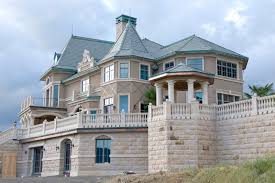Home > Old houses > Chateauesque
Chateauesque
Chateauesque is an architectural style that originated in the 18th century in France and continues to be a popular style in modern times. The style uses curves, turrets (castle-like features), and other traditional features with a unique blend of symmetrical elements such as grand staircases, column lined porches, and galleries with lighter and airier lines. Chateauesque features can be seen in stately homes, country homes, places of education, and governmental buildings across the world.
A Chateauesque building has distinctly elegant and regal qualities. The style is a fusion of French, English, Italian, and German elements, that have made the classic style of architecture an admired selection today. The name Chateauesque is derived from "chateau", a French term for a large castle-like residence. Chateauesque is often referred to as the "Prince of Styles".
The exterior of Chateauesque structures tends to be characterised by towers, turrets, conical roofs, balustrades, and porches. Grand staircases, courtyards, and long gallery windows are also common features of the outside of these buildings. Decorative crowns, ornate crestings, and copper-clad turrets are all visually appealing features that provide a drawing card for Chateauesque structures. The use of stone, limestone, bricks, marble and other materials are commonly seen in Chateauesque style buildings. Interiors are typically richly decorated, with intricately moulded ceilings, plaster walls and floors, elaborately carved woodwork on fireplaces and doorways, and marble and tile accents.
The floor plans of Chateauesque homes are one of the style's distinct features that can be great conversation starters and a great way to teach guests about the style's history. Common to its floor plans are to include a grand entryway that is featured with displays of art, furniture, and sculptures. This connects to a large central room that is used for formal dining or entertaining. Other Chateauesque details include tall windows, balconies, and balconettes, and multiple floors or terraces, often with distant views of the landscape.
Inside, the walls are typically painted in natural, rich colors. Plaster, often with characters painted on them, further features in the style. Fabrics in deep purples, plums, and reds, can also be seen in the form of rugs, upholstery, and bedding. The furniture is often intricately carved and features French-style pieces like armoires and cabriolets and other European-inspired antiques.
The Chateauesque style has evolved to meet modern times and many people have adapted this style with contemporary design elements and energy efficient building materials. It is a perfect mix of form and function and can provide a sense of luxury and elegance that is timeless. Depending on the materials used and the surrounding environment, Chateauesque structures can have a strong sense of grandeur throughout the years. Chateauesque structures can serve as a conversation starter for guests to admire both the style and the architecture itself. This timeless style of architecture is perfect for anyone looking to add a little bit of grandeur and beauty to their abode.
Chateauesque is a style of architecture inspired by the grand French chateaux of the 16th and 17th centuries. This style of architecture combines elements from multiple time periods, creating a unique and timeless aesthetic. The defining features of the Chateauesque style include symmetrical eaves, steeply pitched roofs with multiple dormers, elaborate perimeter walls, and towers with conical roofs. The materials used for these structures are typically stone and brick. Through the use of ornamental detailing such as moldings, balconies, spires, and quoins, this style of architecture creates a strong sense of grandeur and majesty.
When designing a Chateauesque style home, it is important to focus on details that draw inspiration from both classical and modern architecture. One of the primary elements of the Chateauesque style is symmetry. The main structure or the main 'U' shape should be symmetrical, with matching elements including dormers, eaves and towers. Symmetry also extends to the formal gardens and outdoor areas, such as manicured lawns and symmetrical plantings. The walls of these buildings are typically constructed using brick, stonework or a combination of both. Windows are typically rectangular, usually with elaborate arching treatments and intricate trim work. Main entry doors are usually grand, with a heavy, ornate frame. Other robust elements are also commonly incorporated into the overall design, such as quoins, crenellations and balconies. These elements help to create a grandiose feel for the property.
The overall roofline of Chateauesque style buildings is usually steeply pitched, as well as highly ornate. Dormers created from gables, hipped and hipped-with-gable end combinations, parapets or turrets, are common features. And, unlike some other architectural styles, dormers in the Chateauesque style can be arranged in any pattern desired, creating a unique roofline.
When it comes to outdoor landscaping, the goal is to create a formal, garden-like feel that compliments the grand architecture of the building. This can be done through the use of symmetrical plantings and the implementation of pathways and accent elements such as fountains or water fixtures. In terms of colors, dark and rich hues are very typical for the Chateauesque style. Multicolored brick or stonework, as well as accents such as ornamental ironwork, can be used to create a unique look and feel. The result is a cohesive, grandiose affair that is sure to impress.
In summary, Chateauesque style architecture is a unique and timeless way to architecturally combine elements from multiple time periods to create an impressive façade. When designing a Chateauesque style home, symmetry and ornate details should be the focus, including steeply pitched roofs, turrets, balconies, and quoins. Additionally, heavy stone or brickwork, and dark and rich hues will help bring the design together. Lastly, the outdoor landscaping should be formal, with symmetrical plantings and other accents. By utilizing the fundamentals of the Chateauesque style, architects can craft a building that will stand the test of time and remain timeless for many years to come.










